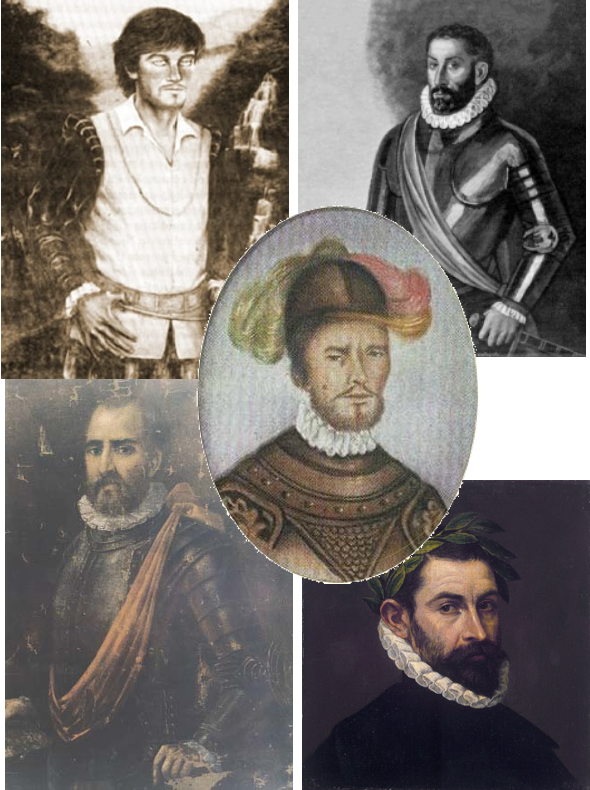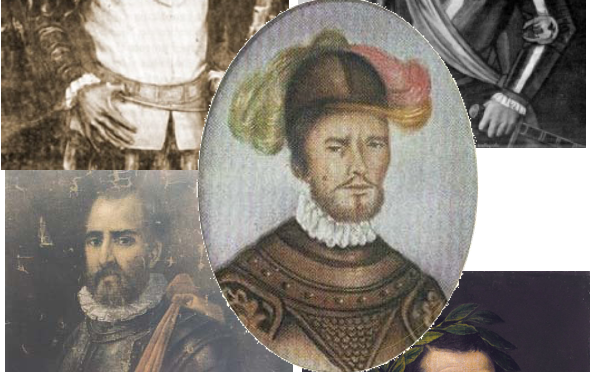The Basques have always been known for their adventurous spirit. Their search for fishing grounds took them to Iceland and beyond, reaching the coast of what would become Canada, where they established whale processing sites and developed a pidgin with the local Native Americans (and the Icelanders too). However, they also played a big role in the Castilian conquest of the Americas. Their expertise as seamen made them valuable to both France and Castile. Much of the current shape of the Americas is due to the actions of the many Basques who were part of the conquest.

- From the beginning, Basques were there. Christopher Columbus’ expedition contained Basque seamen. The first Castilian colony in the Americas, Fort Navidad (created from the wreckage of the ship Santa Maria), had a number of Basque settlers, including the Santa Maria‘s boatswain, a Basque from Leikeito nicknamed “Chachu.”
- In the early stages of the conquest and colonization of the Americas, that time between 1492 and 1520 referred to as the “Great Explorations,” Europeans didn’t tend to conquer large regions but rather made expeditions to trade with the local inhabitants. In this setting, Basque shipowners such as Sancho Ortiz de Urruela and Juan de Urrutia obtained permission for such expeditions along the Cumaná coast of modern Venezuela in 1519.
- Dominion over the Americas began with the conquest of the Aztec empire and other parts of what became Mexico. Starting from the newly-formed Mexico City, built upon the ashes of the former Aztec capital Tenochtitlán, expeditions sought to expand the empire. Basques were central to this expansion, with the modern cities of Guadalajara and Zacatecas founded by Cristobal de Oñate (from Gasteiz, 1504-1567). Many other Basques came with him, including Santiago Aguirre, Juan Anuncibay, Alfonso Gaztañaga, Miguel Landeta, and Martin de Renteria.
- As the empire expanded to the north, Basques were there. In 1563, a group led by Francisco de Ibarra, native of Eibar, who set out in search of the mythical land of Cíbola and founded the city of Durango, as the capital of a vast territory that received the name of Nueva Vizcaya. Juan de Oñate, the American Creole son of Cristóbal, followed in his father’s footsteps and conquered New Mexico in 1598. He is infamous for his actions in the Aroma War, where he was said to have cut off one foot of of every male 12 years and older for punishment. Juan de Montaño (Portugalete) took part in the expedition that reached the California peninsula in 1535.
- To the south, Pascual de Andagoya from Andagoia, Araba, captained the first attempt to conquer Peru and the Incan empire. While his attempt in 1522 would end in failure, the news he spread about that kingdom led to its fall a few years later
- After the fall of the Incas, the conquest entered a third phase, distinguished by expeditions to explore and conquer the rest of the Americas. Pedro de Ursua (Baztan, Nafarroa) led an expedition up the Amazon in search of the mythical El Dorado. There were many Basques who joined this expedition, among them the infamous Lope de Aguirre “El Loco” (Oñati, Gipuzkoa). Alonso de Ercilla, of Bizkaian origin, distinguished himself in the conquest of Chile.
- In the Rio de la Plata region, Domingo Martinez de Irala (Bergara, Gipuzkoa) was involved in the founding of Buenos Aires in 1536. Years later, in an effort to link Peru to the Atlantic Ocean, Juan Ortiz de Zarate (Orduña, Bizkaia) led an army to establish such a route. His forces were defeated by the Charrúa in present-day Uruguay, and he had to be rescued by Juan de Garay, who may also have been from Orduña. Garay founded, amongst several cities, the second founding of Buenos Aires.
- This is just a brief overview of some of the Basque who were involved in the conquest of the Americas. Stephen Bass has pulled together an extensive and outstanding history, documenting all of the Basque involvement in the Americas he could find. His Basques in the Americas From 1492 to1892: A Chronology is truly impressive.
Primary source: Álvarez Gila, Óscar. Vascos en la conquista y colonización de América. Enciclopedia Auñamendi. Available at: http://aunamendi.eusko-ikaskuntza.eus/es/vascos-en-la-conquista-y-colonizacion-de-america/ar-28435/
Note: The article in the Enciclopedia Auñamendi states “Juan de Ibarra” was the founder of the city of Durango, Mexico, but everything else I can find says it was “Francisco de Ibarra.” Also, some say he was from Eibar, but other sources say he named Durango after his home town.
Discover more from Buber's Basque Page
Subscribe to get the latest posts sent to your email.



Greetings,
Regarding Juan de Onate—” where it was said to have cut off one foot of every male 12 years and older” not to defend the actions of Onate but, thus far, it was not proven that the sentence was carried out.
I was an archivist at the Center for Southwest Research/Zimmerman Library at UNM–the question came up 2 or 3 times a year from community patrons as well as the UNM community. At the Center, there is at the Center photo copies of Los Archivos de las Indias–the original papers are housed in Seville, Spain. At the Center, the photo copies are about what pertains to NM.
Priests came with the soldiers–it was a conquest of land and of souls–to spread the Catholic faith. Priests recorded daily life, important events, battles–every thing. Written by hand, of course, no punctuation, no capital letters and written in the Spanish of the time. It was the first place we looked. We also networked with other U. I received the newsletter from the Basque Center in Nevada and would call some folks.
About 6 years before I retired, a colleague and good friend and me, had a long conversation with a couple, Elders from Acoma. It was during Spring break –we had time to relax and have nice visit with the few visitors. During the conversation, Onate came up. My colleague and I felt comfortable to ask about the sentence. The Elders told us that they new about the sentence but they said that in their chants, old stories, religious ceremony, there was never a mention of foot being cut off.
Maybe in the future, as more documents come to light, we may find out.
Archival work is tedious–it may take years to process a large collection-Donor’s collection sit for years in attic, basement–in boxes with rats doo doo, spiders, mold–it must me cleaned up, process, properly stores and much more. and it is expensive to maintain an archive. Hight praise to the conservation lab.
So folks, when you read all this good information coming up on your computer screen, thank Buber and his pals and all the staff in libraries and archives and please, do not tear up pages from a book.
Monique
Thanks Monique. I’ve heard that there may not be direct evidence of this (hence my wording of “it is said”) but he certainly was brutal enough that the Crown recalled him back to Spain and he was punished. He wasn’t a nice guy, regardless of whether he actually carried out the sentence or not. Ultimately he was “convicted by the Spanish government of using ‘excessive force'” (according to Wikipedia) so even for his time he was a pretty nasty man. But, they also note that there is no evidence for cutting off the feet of the prisoners, and that maybe, in the end, only toes were cut off.
Yes, I noted “it is said” and very few people phrase the incident the way you did.
My comment was not in defense of Onate. That being said, I do not believe that Onate was worse than any other conqueror–he just got caught.
It is a fact that the nature of wars and conquests is brutal.
A long time ago, I read a document of the atrocity the Spaniards inflicted on the Chichimecas of Mexico–and they fed their dogs with the body of the badly wounded Indians.
I worked with Pueblo, Tribe and Hispanic community–read many documents, listen to many oral history tapes, spoke to the Elders, the young and in between and I can say that the Spaniards, the French, Dutch, the British. the Americans got back as good as they gave to the tribes and to the pueblos.
But, there was not always peace and harmony within the native tribe and pueblos either.
The pueblos still in existence along the Rio Bravo ( Grande) are practicing their religion, enjoying their own culture thanks to the protection of the Spaniard. The Pueblos requested protection against the marauding tribes–Navajos, Apaches and others. To this day, some Pueblos folks refer to the Apaches as head smasher–smashing heads was the favorite form of war fare.
Monique